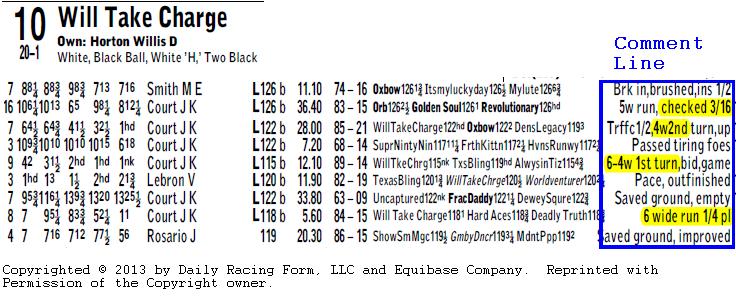Trip Notes
In a prior post we briefly introduced trip notes in conjunction with a review of full trip descriptions in result charts. Click here to see that post. In this post we’re going to focus on the terminology used in the abbreviated trip notes shown in the Past Performances (PPs) of each horse. These trip notes are part of what is referred to as the comment line in the PPs.
The comment line is a subset of the full description found in the result chart for a specific horse. Since it is confined to one line and relatively few characters, it can be rather cryptic to read. DRF describes the contents of the comment line as follows:
A capsule description of the horse’s performance written by the chart caller. Emphasis is placed on trouble encountered during the race and/or how it finished. If the horse won the race, the manner in which it won is indicated – driving, ridden out, handily or easily (in order of effort).
Here we will provide some examples and further description of some comment terminology used in the comments.
Below is an excerpt from the PPs of Will Take Charge with the comment lines clearly marked. Included is the running lines for reference as we review the trip notes.

We’ve highlighted a couple of examples to use as demonstration.
| Trip Note | Explanation |
|---|---|
| checked 3/16 | The jockey was forced to slow him up a bit at the 3/16 pole (meaning 3/16 of a mile from the finish line. |
| 4w2nd | He was 4-wide (3 horses on his inside) in the track around the 2nd turn. |
| 6-4w 1st turn | This one even fooled me. I had to review the result chart to see it said, “six wide into the first turn, four wide onto the backstretch. |
| 6 wide run 1/4 pl | He was 6-wide at the 1/4 pole (1/4 mile from the finish line). |
From this example you can see there can be much variation in the way information is presented. When able to fit “wide” and “turn” in the comment they did, but other times it was shortened or left off entirely. This is common; as there is no standard on how comment lines are written. And, chart callers are different for every track. However, you will find that as you get used to reading the comment lines it will make sense. In the case where one confuses you, like the third example here, a quick review of the result chart will clarify what was intended.
The following table lists some of the more common terms used and the associated meaning for the term:
| Term | Meaning |
|---|---|
| checked | Due to other horses, a jockey is forced to slow a horse’s momentum. The degree can vary, and sometimes the note will indicate something more severe, e.g. “checked sharply.” |
| # wide | Placement of a horse on the course, e.g. 3-wide means the horse was in the 3rd position from the rail with two horses on his inside. This is often abbreviated to #w (e.g. 3w or 6w). In general, being wide means a horse had to run farther than horses to his inside during the race. |
| # turn | Indicates on which turn something occurred, e.g. 1st or 2nd. However, as in the example above, sometimes “turn” is implied when combined with another term. E.g. “6w 1st” would mean 6-wide into the first turn. |
| # path | Tells what “path” a horse is running in the race. Sometimes shortened to just “p”. E.g. “2-path” and “2p” mean the same thing. Usually describes the horses position over a sustained distance, for example “dueled in 2p” means the horse was fighting for the lead on the outside of another horse. |
| x/y pole | x/y indicates a fraction (e.g. 1/8, 1/4, or 3/16). Though “pole” is rarely shown, the fraction represents the pole marker, or distance from the finish line where something happened. E.g. “checked 1/16” indicates the horse was forced to slow down very close to the finish line. |
| bobbled | The horse took a bad step, sometimes causing the horse to lose momentum for a brief period of time. |
| stumbled | Worse than a bobble, could have dipped down to the point of nearly losing the jockey or falling. |
| greenly | Usually connected with a lack of experience, e.g. not running in a straight line down the stretch. |
| rank | Difficult for the jockey to control, e.g. resisting a jockey’s attempt to slow a horse down early in a race. |
| steadied | Basically the same as checked, and refers to a slowing of momentum initiated by the jockey due to traffic troubles. |
| upper | Refers to upper stretch, e.g. “5w upper” means 5-wide in upper stretch. |
| hung | A horse that is running well in the stretch, and has every chance to win a race, but falls short for no apparent reason. |
These are some of the more common terms you will encounter in your handicapping. For a more complete list, refer to the “Guide to Race Comments” on Equibase.

One comment on “Trip Notes”